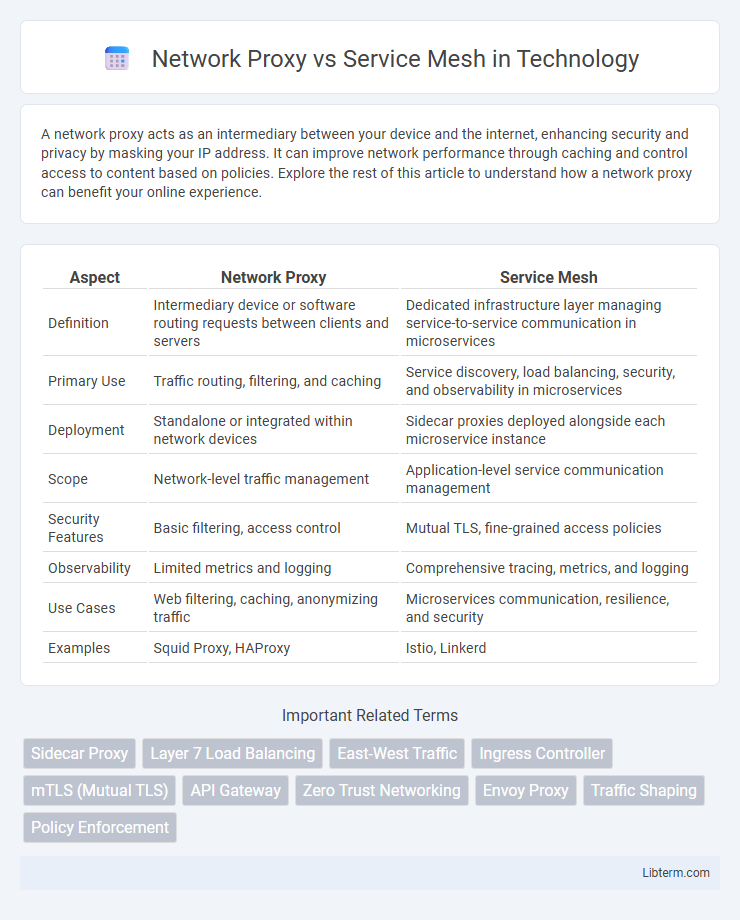A network proxy acts as an intermediary between your device and the internet, enhancing security and privacy by masking your IP address. It can improve network performance through caching and control access to content based on policies. Explore the rest of this article to understand how a network proxy can benefit your online experience.
Table of Comparison
| Aspect | Network Proxy | Service Mesh |
|---|---|---|
| Definition | Intermediary device or software routing requests between clients and servers | Dedicated infrastructure layer managing service-to-service communication in microservices |
| Primary Use | Traffic routing, filtering, and caching | Service discovery, load balancing, security, and observability in microservices |
| Deployment | Standalone or integrated within network devices | Sidecar proxies deployed alongside each microservice instance |
| Scope | Network-level traffic management | Application-level service communication management |
| Security Features | Basic filtering, access control | Mutual TLS, fine-grained access policies |
| Observability | Limited metrics and logging | Comprehensive tracing, metrics, and logging |
| Use Cases | Web filtering, caching, anonymizing traffic | Microservices communication, resilience, and security |
| Examples | Squid Proxy, HAProxy | Istio, Linkerd |
Introduction to Network Proxy and Service Mesh
Network proxies act as intermediaries that route client requests to servers, enhancing load balancing, security, and traffic management in network communication. Service meshes provide a dedicated infrastructure layer that controls service-to-service communication within microservices architectures, offering features like observability, security, and resilience without modifying application code. Unlike basic network proxies, service meshes integrate with orchestration platforms to manage complex service interactions across distributed systems.
Core Concepts: How Network Proxies Work
Network proxies act as intermediaries that forward client requests to servers, managing traffic through functionalities like load balancing, caching, and protocol translation. They operate primarily at the network and transport layers by intercepting and routing packets, ensuring secure and efficient communication between endpoints. These proxies often serve as a foundational component within service mesh architectures to enhance observability and traffic control.
Core Concepts: What is a Service Mesh?
A service mesh is an infrastructure layer that manages service-to-service communication within a microservices architecture by providing features like load balancing, service discovery, and secure communication, often implemented via sidecar proxies. Unlike a traditional network proxy that routes traffic primarily at the edge of a network, a service mesh operates at the application level, enabling fine-grained control, observability, and resilience between services. Core components of a service mesh include data plane proxies and a control plane that orchestrates policies and traffic management across distributed services.
Key Differences Between Network Proxy and Service Mesh
Network proxies primarily handle traffic routing, security, and load balancing by managing requests at the network layer, whereas service meshes provide comprehensive service-to-service communication management with features like observability, policy enforcement, and security at the application layer. Service meshes use sidecar proxies deployed alongside application instances to enable fine-grained control and telemetry, while traditional network proxies act as centralized intermediaries. The key difference lies in the scope and granularity of control, where service meshes enhance microservices architecture by managing service communication beyond basic proxy capabilities.
Use Cases: When to Choose Network Proxy
Network proxies excel in scenarios requiring simple traffic routing, centralized access control, and basic load balancing across distributed services. They are ideal for legacy applications needing minimal configuration, HTTP/HTTPS filtering, or when rapid deployment is critical without the complexity of a full service mesh. Network proxies also suit environments where traffic management is limited to ingress/egress points rather than requiring detailed service-to-service communication policies.
Use Cases: When to Implement a Service Mesh
Service meshes are ideal for managing complex microservices architectures requiring fine-grained traffic control, security policies, and observability across distributed services. Network proxies are suitable for basic routing, load balancing, and simple security at the edge or monolithic applications. Implement a service mesh when you need service-to-service encryption, real-time telemetry, advanced failure recovery, or multi-cluster communication beyond traditional proxy capabilities.
Scalability and Performance Comparisons
Network proxies provide basic traffic routing and load balancing, suitable for simpler, smaller-scale environments but often introduce latency as traffic volume grows. Service meshes integrate network proxies with advanced control planes, offering enhanced scalability through dynamic service discovery, traffic splitting, and observability while optimizing performance with features like circuit breaking and retries. Large-scale microservices architectures benefit from service meshes by efficiently managing inter-service communication, reducing latency spikes, and ensuring consistent performance under high loads.
Security Implications: Proxy vs Service Mesh
Network proxies offer basic security by controlling traffic flow and enforcing access policies at the network edge, but they lack granular observability and dynamic policy enforcement. Service meshes provide enhanced security through mutual TLS for encrypted communication, fine-grained access control, and automated certificate management, enabling zero-trust networking within microservices environments. Consequently, service meshes deliver superior protection against lateral movement attacks and facilitate secure service-to-service interactions compared to traditional proxies.
Management and Observability Features
Network proxies primarily handle traffic routing and basic load balancing, offering limited management features such as simple access control and IP filtering. Service meshes provide advanced management capabilities including fine-grained traffic control, policy enforcement, secure service-to-service communication, and comprehensive observability through distributed tracing, metrics collection, and centralized logging. The integration of telemetry and policy layers within service meshes enables detailed visibility and control over microservices environments, surpassing the capabilities of standalone network proxies.
Conclusion: Selecting the Right Solution for Your Needs
Choosing between a network proxy and a service mesh depends on the complexity and scale of your microservices architecture. Network proxies offer straightforward traffic management and security features suitable for simpler, smaller deployments. Service meshes provide advanced observability, dynamic routing, and resilience capabilities necessary for large-scale, distributed systems requiring fine-grained control.
Network Proxy Infographic

 libterm.com
libterm.com